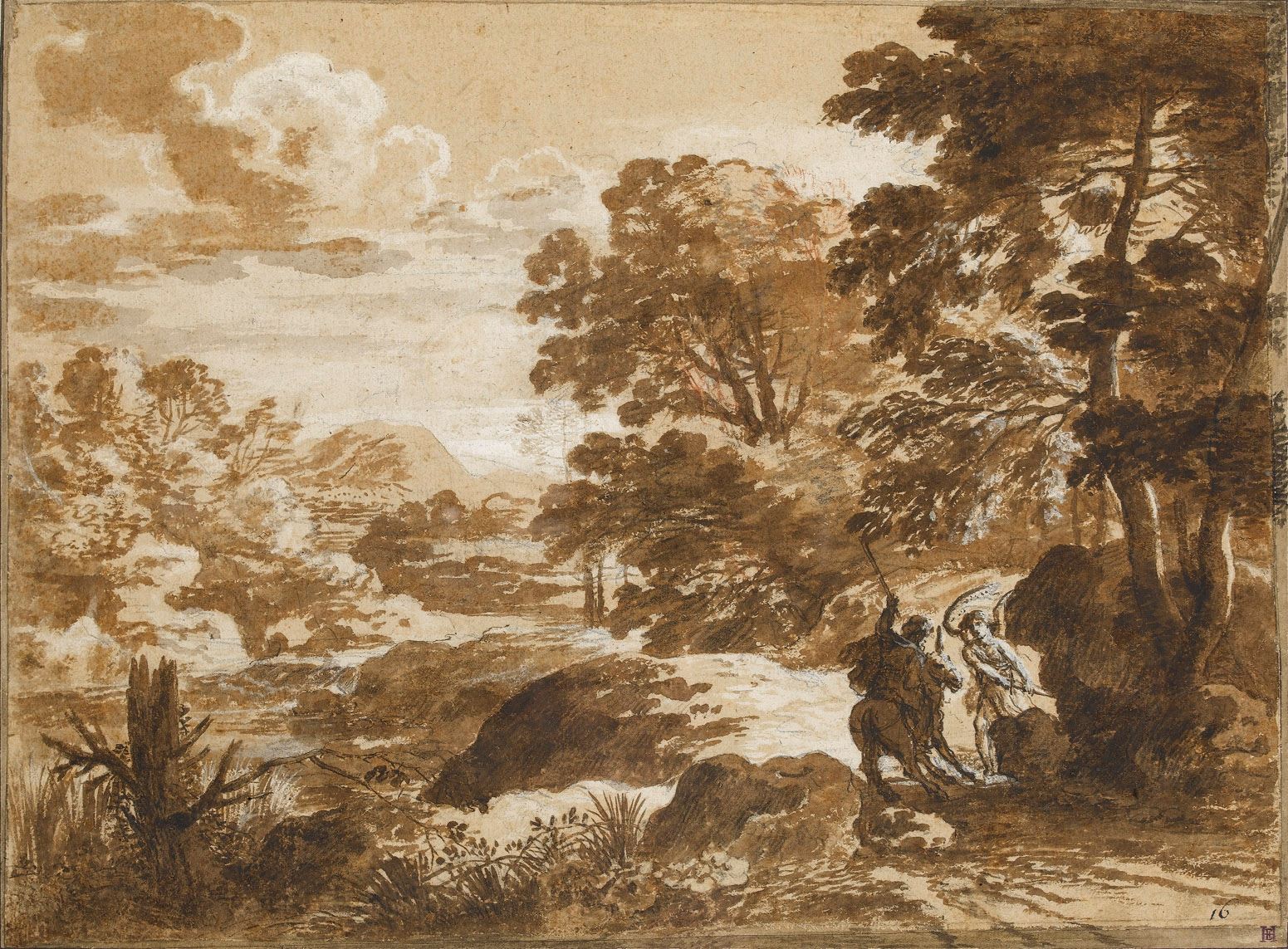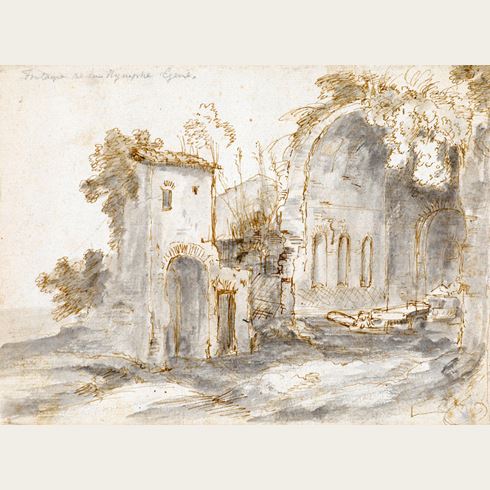Herman van SWANEVELT
(Woerden 1603 - Paris 1655)
Landscape with Balaam and the Angel
Sold
Pen and brown ink and brown and grey wash, heightened with white, over an underdrawing in black and red chalk.
The sheet extended with a narrow strip on all four sides, and laid down on an old mount.
Numbered 16 at the lower right.
236 x 319 mm. (9 1/2 x 12 1/2 in.)
The sheet extended with a narrow strip on all four sides, and laid down on an old mount.
Numbered 16 at the lower right.
236 x 319 mm. (9 1/2 x 12 1/2 in.)
This fine drawing is a preparatory study, of the same dimensions and in reverse, for an etching by Swanevelt of Balaam and the Angel, published by Claude Audran. The third state of the print adds an inscription to the effect that the drawing was done by Swanevelt in Rome, although precisely when during the twelve or so years that the artist spent in Italy the drawing was made is difficult to determine. The print itself may well have been published several years later, however.
This drawing highlights the particularly close relationship between Swanevelt’s landscape drawings and those of his contemporary in Rome, Claude Lorrain. While Swanevelt was for a long time thought to be a follower of Claude, recent scholarship has convincingly argued instead that the artists seem to have influenced each other. Exact contemporaries, they were subject to the same influences and inspirations in their sketching trips around Rome, and often used the same technique of brush and wash in their drawings. As has been noted, ‘By far the most consistent presence in Swanevelt’s drawings is that of Claude…In terms of mood, composition and light, the affinities between the two artists are incontestable…More importantly, Swanevelt and Claude are alike in their rhythms and in the synthesis of figure and landscape…the two artists developed side by side.’ Drawings by the two artists have long been confused, and numerous examples by Swanevelt have at one time born attributions to Claude.
The use of a combination of brown and grey wash in the present sheet is characteristic of Swanevelt’s mature landscape drawings, which have been described as ‘almost painterly in the use of washes to suggest shadow, and the wash hues mould the landscape forms.’ The drawing may be compared stylistically with a number of Swanevelt’s later preparatory studies for prints. Drawings such as these are, in the words of one scholar, ‘the record of Swanevelt’s response to the stimulus of the Roman Campagna, expressed in the classical vocabulary through which artists in Rome were defining landscape…his drawings are highly controlled and methodical products, and yet they do have that freshness that the paintings sometimes lack.’
It may further be noted that such highly finished and attractive drawings as the present sheet, while serving as models for prints, were in all likelihood also brought to a finished state to be sold as works of art in their own right. As Marcel Roethslisberger has pointed out, ‘It must be assumed that such pictorially finished drawings were not merely done as preparatory studies or models, but as ends in themselves, for sale – a practice firmly established since the sixteenth century among the Italianizing landscape artists from the north.’
This drawing highlights the particularly close relationship between Swanevelt’s landscape drawings and those of his contemporary in Rome, Claude Lorrain. While Swanevelt was for a long time thought to be a follower of Claude, recent scholarship has convincingly argued instead that the artists seem to have influenced each other. Exact contemporaries, they were subject to the same influences and inspirations in their sketching trips around Rome, and often used the same technique of brush and wash in their drawings. As has been noted, ‘By far the most consistent presence in Swanevelt’s drawings is that of Claude…In terms of mood, composition and light, the affinities between the two artists are incontestable…More importantly, Swanevelt and Claude are alike in their rhythms and in the synthesis of figure and landscape…the two artists developed side by side.’ Drawings by the two artists have long been confused, and numerous examples by Swanevelt have at one time born attributions to Claude.
The use of a combination of brown and grey wash in the present sheet is characteristic of Swanevelt’s mature landscape drawings, which have been described as ‘almost painterly in the use of washes to suggest shadow, and the wash hues mould the landscape forms.’ The drawing may be compared stylistically with a number of Swanevelt’s later preparatory studies for prints. Drawings such as these are, in the words of one scholar, ‘the record of Swanevelt’s response to the stimulus of the Roman Campagna, expressed in the classical vocabulary through which artists in Rome were defining landscape…his drawings are highly controlled and methodical products, and yet they do have that freshness that the paintings sometimes lack.’
It may further be noted that such highly finished and attractive drawings as the present sheet, while serving as models for prints, were in all likelihood also brought to a finished state to be sold as works of art in their own right. As Marcel Roethslisberger has pointed out, ‘It must be assumed that such pictorially finished drawings were not merely done as preparatory studies or models, but as ends in themselves, for sale – a practice firmly established since the sixteenth century among the Italianizing landscape artists from the north.’
A painter, draughtsman and etcher, Herman van Swanevelt seems to have briefly visited Paris in 1623 before settling in Rome, where he lived for several years, between 1629 and 1641. He befriended several French artists in the city, and is almost certain to have come into contact with Claude Lorrain. Like Claude, Swanevelt developed a type of ideal landscape in both his paintings and drawings, and the two artists must have known and influenced each other; this is particularly evident in the similarity of their drawings, with their emphasis on effects of light and atmosphere. When he was admitted into the Schildersbent, the association of Netherlandish artists in Rome, Swanevelt was given the nickname ‘Heremyt’ or hermit, apparently because his preference for depictions of Italian ruins often led him deep into the remote countryside around Rome.
Swanevelt’s paintings of landscapes with biblical or mythological subjects were in great demand, and among his most significant patrons in Rome were the Barberini family, for whom he painted frescoes in their palazzo in the Piazza Navona, and Philip IV of Spain, who commissioned a number of large paintings for the Buen Retiro. Other Roman projects included a series of landscape paintings for the Galleria Doria and a pair of lunette frescoes in the sacristy of Santa Maria sopra Minerva, of which one survives. By 1643 Swanevelt was briefly back in the Netherlands, but for much of the later part of his career he lived in Paris, where his work proved very popular. Swanevelt spent the last eleven years of his career in Paris, where among his important commissions was the fresco decoration of the Hôtel Lambert, painted in the mid-1640’s. He was admitted to the Académie Royale in 1653.
Some two hundred landscape drawings by Swanevelt survive today, with the largest extant group - numbering fifty-eight sheets and for the most part consisting of preparatory studies for etchings - in the Uffizi in Florence. A gifted and prolific printmaker, Swanevelt also produced around 118 prints, and provided drawings for other artists to engrave. While in Rome he shared a house with the French printmaker Charles Audran, who published some of his etchings. A significant number of preparatory drawings by Swanevelt for his prints are known, and the etchings tend to follow the designs fairly precisely, with ‘the painterly effects of the drawings…converted into a great richness of surface texture in the print.’
Provenance
Possibly Pierre Crozat, Paris (his number 16 at the lower left)
Possibly his sale, Paris, 10 April-13 May 1741
George Edward Habich, Cassel (Lugt 862)
His sale, Stuttgart, H. G. Gutekunst, 27 April 1899 onwards, lot 637
Anonymous sale, Amsterdam, Sotheby’s, 4 November 2003, lot 99
C. G. Boerner, Düsseldorf, in 2004
Lucien Solanet, Paris
His posthumous sale, Paris, Hôtel Drouot, 27 March 2008, lot 21.
Literature
Anne Charlotte Steland, Herman van Swanevelt (um 1603-1655): Gemälde und Zeichnungen, Petersberg, 2010, Vol.I, p.67, p.255, no.Z1, 13, Vol.II, p.547, fig. Z 9.





